Push notification marketing can be an incredibly powerful channel to leverage for increasing and sustaining customer engagement and retention rates. Click through rates for push notifications are seven times higher than those of emails, and 40% of users interact with push notifications within an hour of receiving them. Push notifications are also incredibly effective in boosting and maintaining user retention rates; according to a study, 61% of new app users receiving push notifications launched the app within the first month, which is more than double the 28% of installers who did not receive push notifications within the same time frame.
Given that push notifications have one of the highest engagement rates across all marketing channels, it’s important for brands and marketers to know how to properly leverage this direct connection to build user trust and loyalty, one push at a time.
What Is Push Notification Marketing?
Push notification marketing is the practice of sending “push” messages to mobile app users in order to encourage active usage, reengagement, and retention. These push messages are clickable pop ups that appear on the user’s screen even when they are not actively engaging with the app. Although the primary use case of push notification marketing is to bring the user back into the app, push notification copy can be tailored to incentivize certain user behaviors; for example, e-commerce apps may want to urge users to complete a purchase, while media apps may want to inform users of a piece of breaking news.
Why Use Push Notifications In Marketing?
There are three main reasons why mobile apps should be using push notification marketing as part of their growth and retention strategy.
1. Direct communication
Push notification marketing is, in short, what marketers dream of. It’s a channel with incredibly high delivery and open rates, allowing for short and sweet messages to be sent directly to a user’s mobile device. While email delivery rates sometimes suffer from soft and hard bounces, push notifications have a delivery rate of 90%, which is 50% higher than that of emails. That being said, the benefit to this channel of direct communication can be a double edged sword. If done effectively, push notification marketing can be used to send immediate, personalized messages that are guaranteed to reach your target audience; but if it’s overdone in terms of frequency, timing, or messaging, it could easily alienate users to a point of no return.
2. User insights
Another key benefit to using push notification marketing is that brands can rapidly gather a large amount of user insights from users’ behavioral data. A/B testing push notifications can be a way to quickly validate hypotheses around ideal messaging, tone of voice, or key value propositions, so that you can get a better understanding of what your users are resonating the most with. Any user insights and learnings that are gained through a rapid experimentation of push notification tests can then also be transferred and applied to marketing efforts on other channels, such as email, paid advertising, or landing pages.
3. Granular segmentation
In the world of marketing, nothing is every one-size-fits-all. Effective push notification marketing allows for extremely granular segmentation opportunities, so that brands can tailor their messaging to specific points in the customer journey to drive action and increase conversion rates. In addition to segmenting by where customers are in their user journey, brands can also segment by the frequency of user activity, by different locations, different devices, or by different demographic or psychographic attributes. By taking a data-driven approach to push notification marketing, careful segmentation can reflect a deeper understanding of each user’s individual needs and increase user engagement and trust over time.
What’s The Difference Between Push Notification Marketing and Email Marketing?
Push notification marketing and email marketing are both organic channels that allow brands to directly communicate with their customers — but that is the extent to their similarities. Push notification marketing and email marketing differ in terms of their ideal format, engagement rates, and communication strategies. While emails provide plenty of digital real estate for in-depth explanations or longer-form messaging, push notifications are generally limited to a maximum of 1-2 short sentences, thus necessitating a certain degree of clarity and concision. Emails also allow for a variety of different end goals, including but not limited to boosting awareness, driving education, or fostering community. Push notifications, on the other hand, tend to be extremely action-driven, with a clear call-to-action that brings the user back into the app.
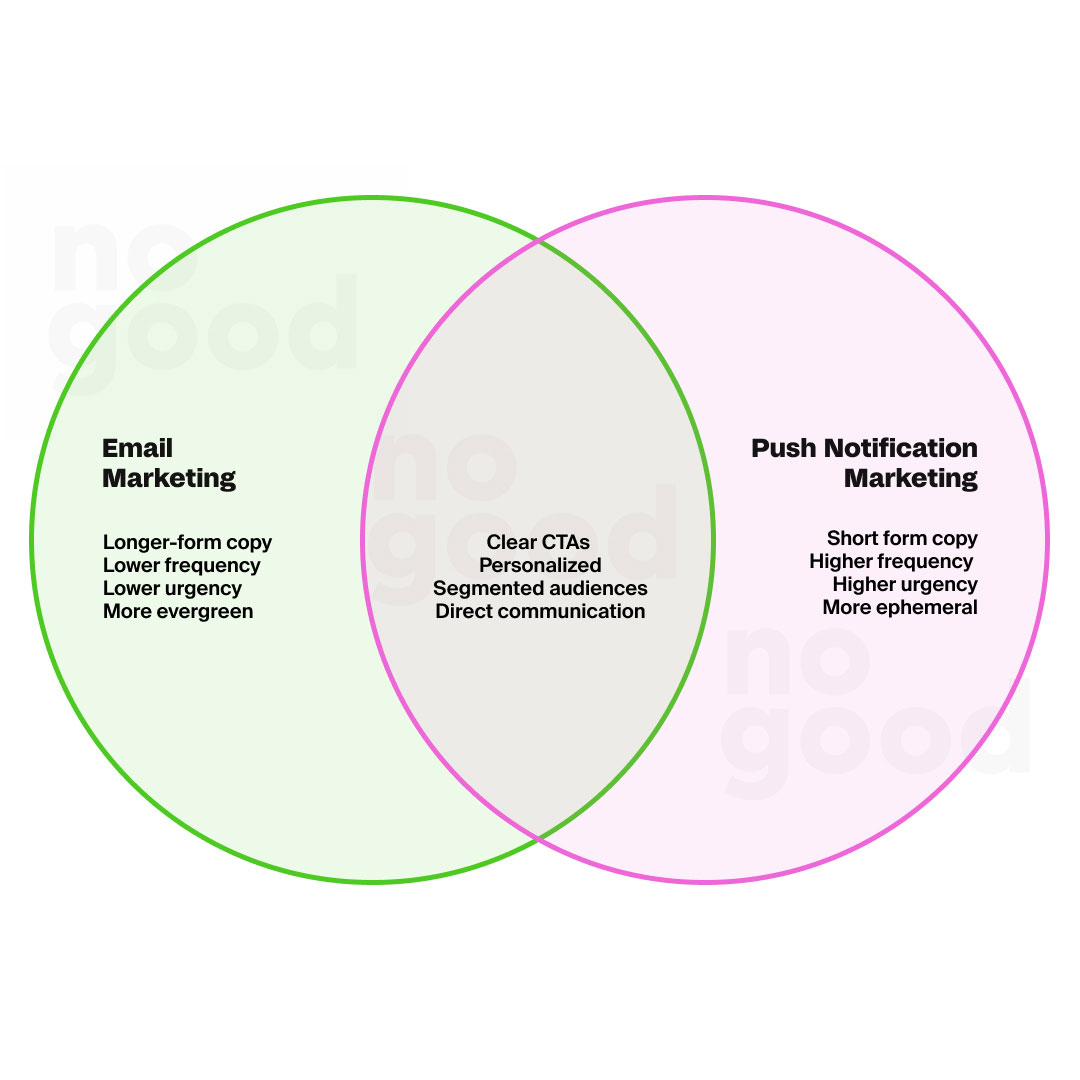
Despite the differences between email marketing and push notification marketing, it’s important for brands and marketers to consider both channels as part of the same holistic marketing strategy, and avoid tactical siloes or redundancies. Push notification marketing should be used to compliment an existing email structure, so that users are receiving a cohesive, end-to-end brand experience across multiple channels. The best type of push notification strategy is one that is part of a multi-pronged integrated campaign that uses consistent cross-channel messaging and leverages the strengths of each channel for optimal communication.
What Are Some Examples Of Push Notification Marketing?
There are many different types of push notifications, but the most common ones that most established mobile apps and brands will have are: welcome pushes, purchase pushes, transactional pushes, reengagement pushes, and milestone pushes.
Here is an explanation and example of each of these push notifications.
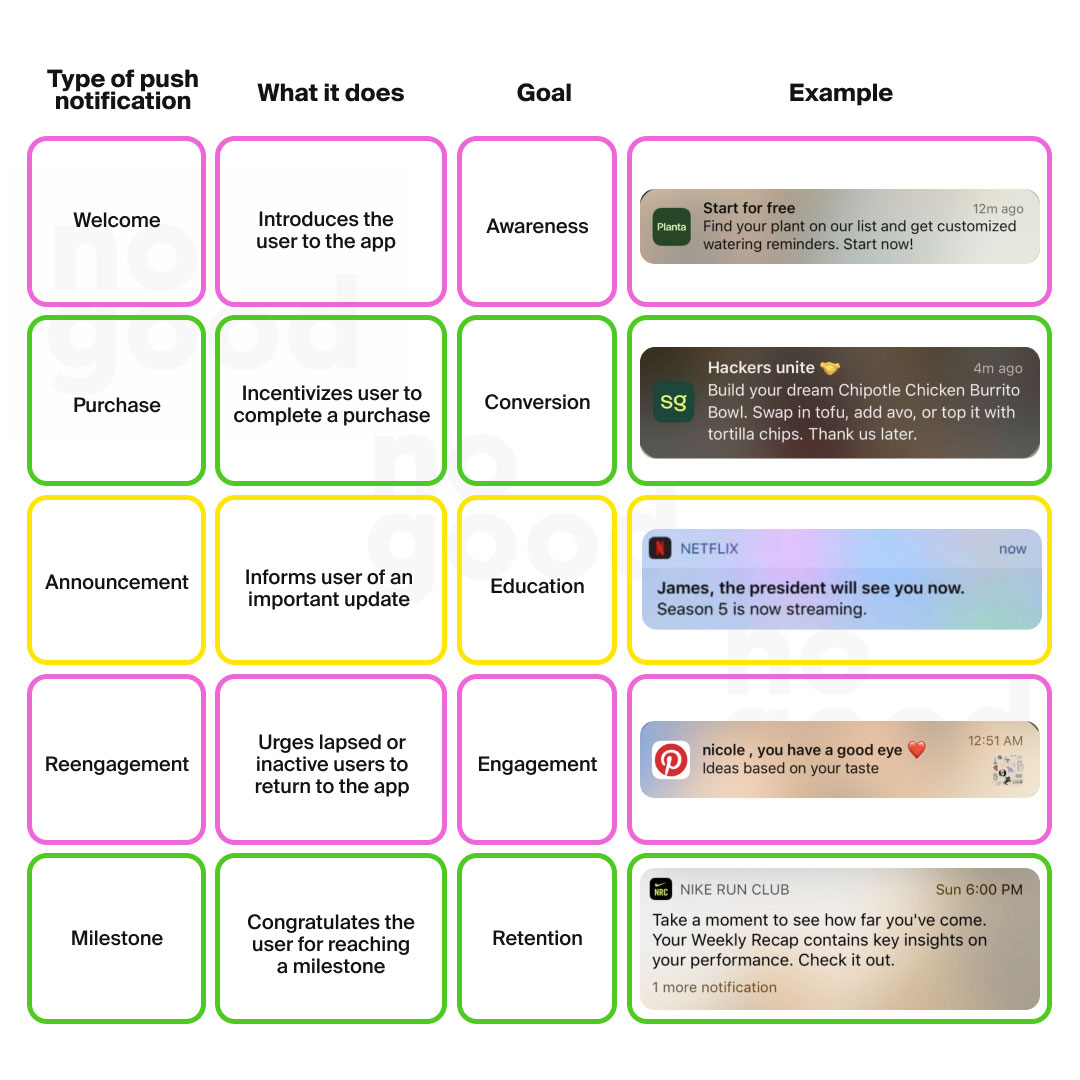
How Do You Get Users To Opt Into Push Notifications?
Prior to the release of Android 13, Android devices automatically opt users in for app notifications when they install an app, which means opt-in rates on Android devices are very high (91.1%). On Android 13 and all iOS devices, users have to opt-in to receive push notifications through tapping a permission prompt, therefore iOS devices have a comparatively lower average opt-in rate of 43.9%.
Opt-in permission prompts are an extremely important key touchpoint for push notification marketing — your entire push notification strategy essentially hinges on the assumption that users are opting in to even receive the notifications you’ve planned for the app. Rather than asking users to opt-in to receiving push notifications immediately after they open the app for the first time, a best practice is to allow the user to have some time to navigate the app, or lead them through an educational onboarding flow, before asking them to opt-in. The fundamental idea is really to ensure that the user has a good understanding of the product and the value that it can bring to their lives, before asking for permission to communicate with them outside of their active usage. Furthermore, permission prompts don’t have to be a one-and-done effort — in most cases it’s beneficial to resurface follow-up prompts at key points in the user journey to capture those that did not initially opt-in; it’s entirely possible that users may change their minds after spending more time with the product.
Headspace does a good job of using a permission priming technique to set the user up to opt-in to their push notifications during the initial onboarding flow. As part of the onboarding flow, Headspace asks users to indicate their goals by answering an “I want to…” with tangible objectives such as “reduce stress”, “manage anxiety”, and “sleep better”. What this question does is it highlights the problem the user is facing, and positions Headspace as the solution to that problem. The screen immediately after this multi-select questionnaire then asks users to opt-in to receive push notifications in order to meet the wellness goal that they just indicated and “get the most out of Headspace”.
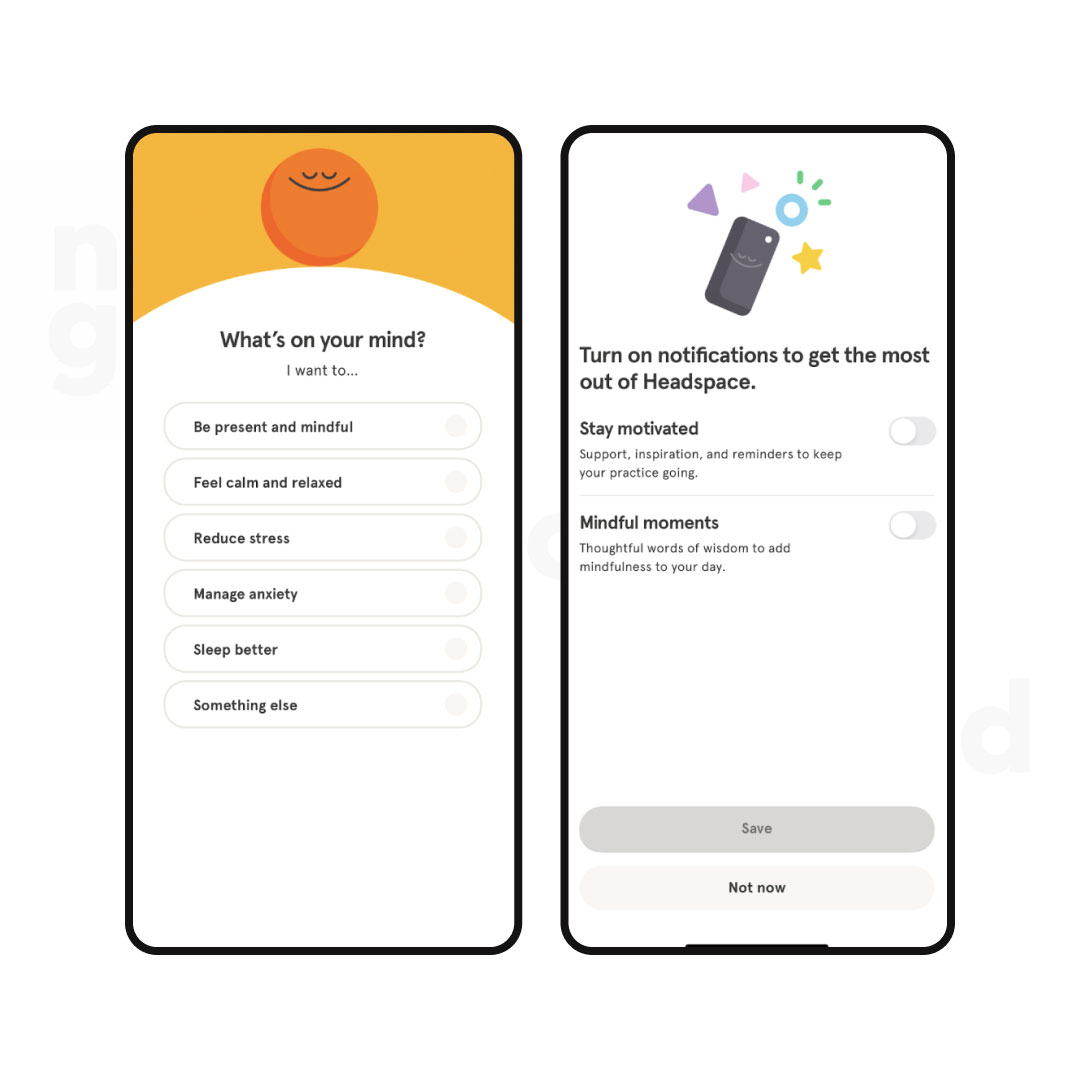
Permission priming can also come in multiple different forms. Plant care app, Planta, shows a preview of the types of notifications that a user might receive and gives the user a heads up on what they are consenting to, so that they feel comfortable with what they are opting into. Another wellness app, Routines, asks users to indicate what time they usually wake up, so that they can send daily notifications as a morning routine reminder. These elements of microcopy and UX interactions creates an engaging experience and curates an environment where the user is driven or even excited to opt-in to receive push notifications.
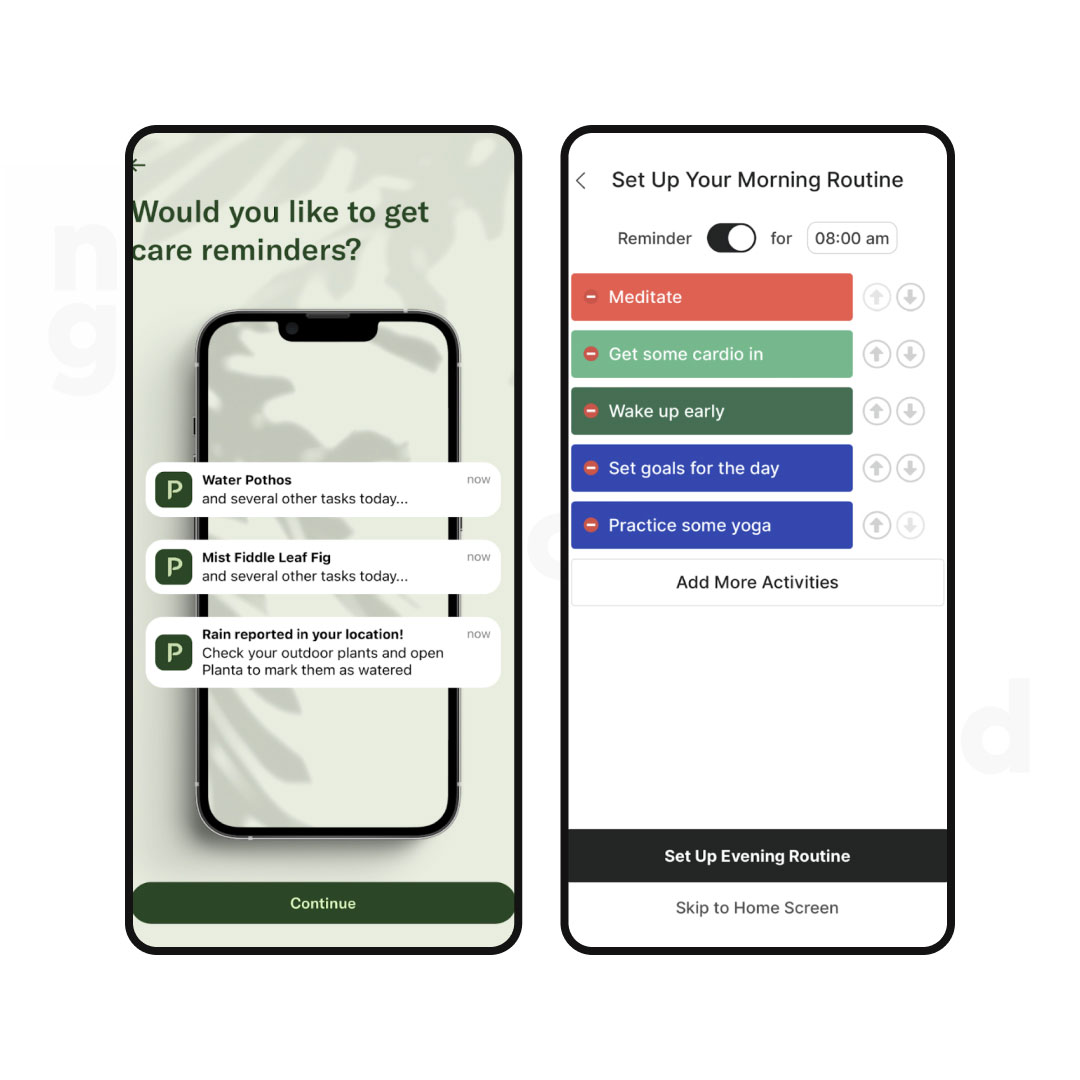
The Best Push Notification Marketing Tools
Just like how email marketing has Klaviyo, MailChimp, Iterable, etc., push notification marketing also has a variety of tools that can help brands streamline and operationalize their push notification strategies. If you’re ready to start executing your push notification marketing strategy, here is a list of the best push notification marketing tools in the game, as well as the pros and cons of each platform.

1. OneSignal
OneSignal is the market leading self-serve customer engagement solution for push and in-app notifications. Despite being a powerful omnichannel platform that enables one million businesses to deliver over 12 billion messages daily, it’s incredibly easy to set up and is user-friendly for brands at any stage of their push notification marketing journey.
Pros: flexible pricing tiers with a free plan available for small businesses
Cons: limited to basic insights such as open and click rates
Pricing: free plan available, $9/month for the growth plan, $99/month for the professional plan, and custom prices for enterprise plans

2. Iterable
Iterable is a customer engagement platform that unifies customer data across channels in real-time and enables dynamic, behavior-based personalization for email and push notifications. With Iterable, brands and marketers can orchestrate seamless customer experiences from activation to retention at scale.
Pros: can transform insights into smarter marketing decisions with AI
Cons: long onboarding timeline, meaning it may not be suitable for those looking to get started immediately
Pricing: custom pricing based on company size and needs (request a demo here)
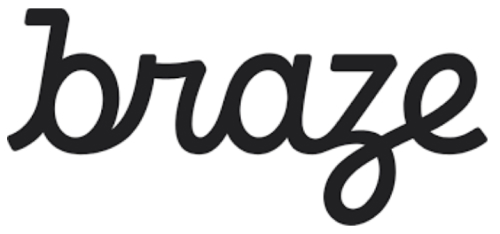
3. Braze
Braze is a leader in cross-channel marketing hubs, forging customer-centric interactions and driving growth with their data-driven customer engagement solution. With its flexible, open ecosystem of channels, Braze allows leading brands worldwide to bring relevant and meaningful customer experiences to life.
Pros: you can build precise audiences based on live-updating data
Cons: SMS is a relatively new product arm of Braze (no access to incoming messages or full link tracking), therefore it may not be the best solution for those looking to use SMS marketing in tandem with push notification marketing
Pricing: custom pricing based on company size and needs (connect with their sales team here)

4. Firebase
Firebase is a set of backend cloud computing services and application development platforms provided by Google. Firebase Cloud Messaging (FCM), their cross-platform messaging solution, lets brands reliably send push notifications at no cost.
Pros: has a large following in the IT community and offers sufficient technical documentation.
Cons: very Android centered with less support for iOS
Pricing: free plan available, with a pay-as-you-go plan that allows scaling up and down as you go.
5 Push Notification Strategies For Boosting Retention
Push notification marketing is a key component of any product-led growth and retention strategy, and knowing how to effectively leverage the channel can lead to significant increases in DAU (daily active users), WAU (weekly active users) and MAU (monthly active users). As an expert in consumer lifecycle management and push notification marketing, here are 5 push notification strategies and best practices for boosting retention and maintaining steady user engagement over time.
1. Leverage data to segment users into insight-driven personas
Audience segmentation can lead to a dramatic increase in push notification click rates. Of the people who open a push notification, 54% of users convert from segmented pushess, compared to only 15% who convert from one-to-all broadcast messages. Using historical data from previous push notification sends or by leveraging user data from other associated channels, you can segment your audience by specific demographic, psychographic or behavioral characteristics and send targeted messages based on those established personas.
Below are some examples of user characteristics that can help you identify and segment different groups of users:
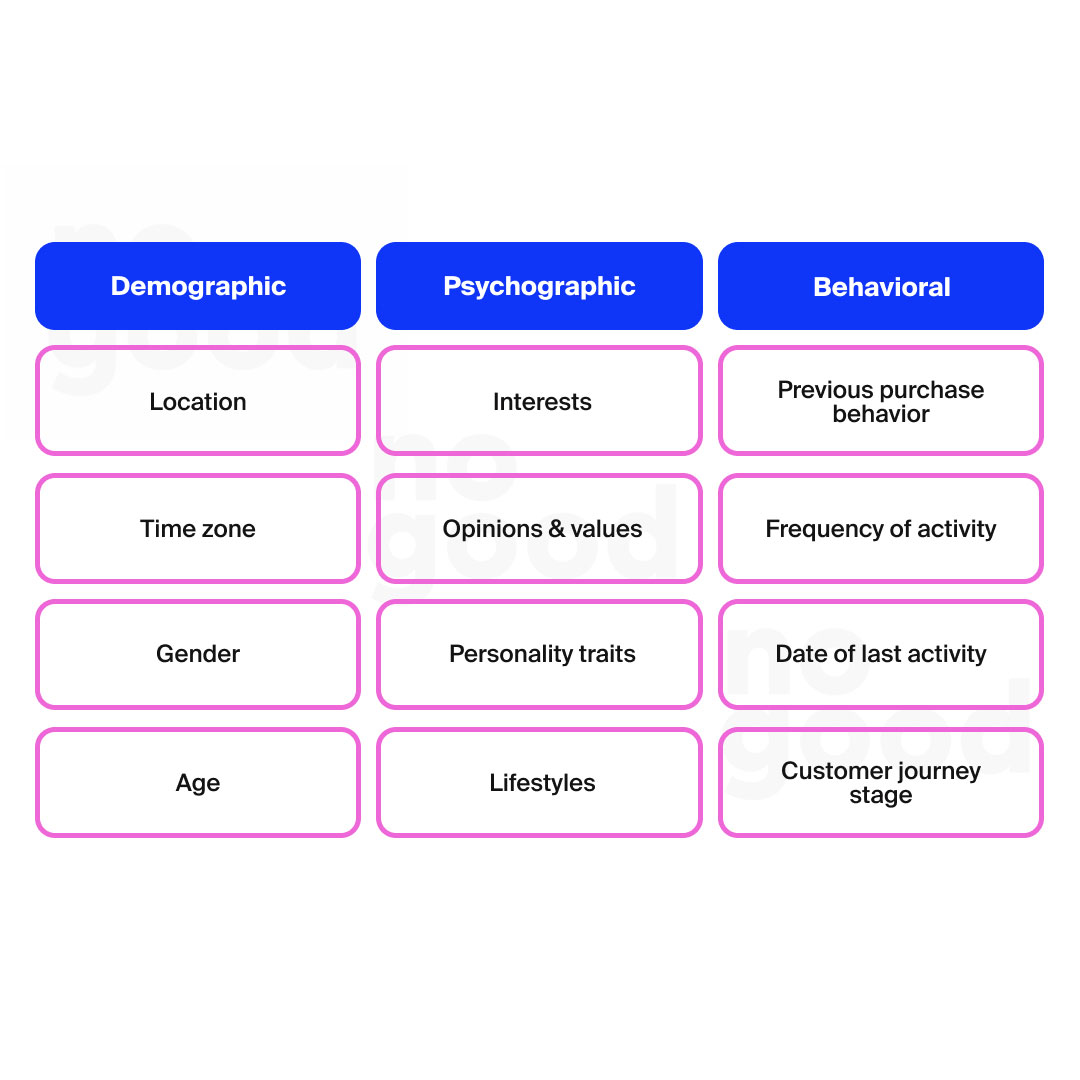
For a news app, you may want to segment your users by location so that you can send notifications about local and regional news stories. For an entertainment app, you may want to send notifications to recommend content based on a user’s interests. For a fitness app, you may want to create specific flows to target users at different points in their journey by segmenting them by the frequency of their activity. When creating a segmentation strategy, keep in mind that all of the above characteristics can be stacked on top of each other to create even more granular segments. The type of push notification can also affect what method of segmentation makes the most sense for the intended goal.
2. Integrate your push notification strategy with other consumer lifecycle marketing channels
No marketing channel should ever be siloed from the overall cross-channel strategy, and given the amount of cross-channel consumer lifecycle marketing tools that are out there, they don’t have to be. Push notification marketing should always be considered as a piece in the bigger marketing puzzle, and should be leveraged to complement existing email and SMS marketing strategies. If your brand is able to interact with customers across a variety of different channels, it’s important to understand which channel to use for which type of communication, so that you avoid overcommunicating or being redundant. Overcommunication and repetitive messaging can lead users to unsubscribe from your channels, leave negative reviews, or in worst cases, abandon the product altogether.
As a general rule, time-sensitive communications that require a specific, immediate action should be sent through SMS or push notifications, whereas more educational or informational messaging can be sent through emails instead.
In rare cases of important updates or key information, messaging can be communicated through multiple channels. However, multi-channel communication should be used sparingly as it does run the risk of being repetitive. A good way to avoid being repetitive is to adapt the message to suit the strengths of each channel; in other words, the same message can be sent through two different channels if it is framed in different ways. For example, LinkedIn sends push notifications for individual new job postings, and then later sends email recaps of multiple recent job postings.
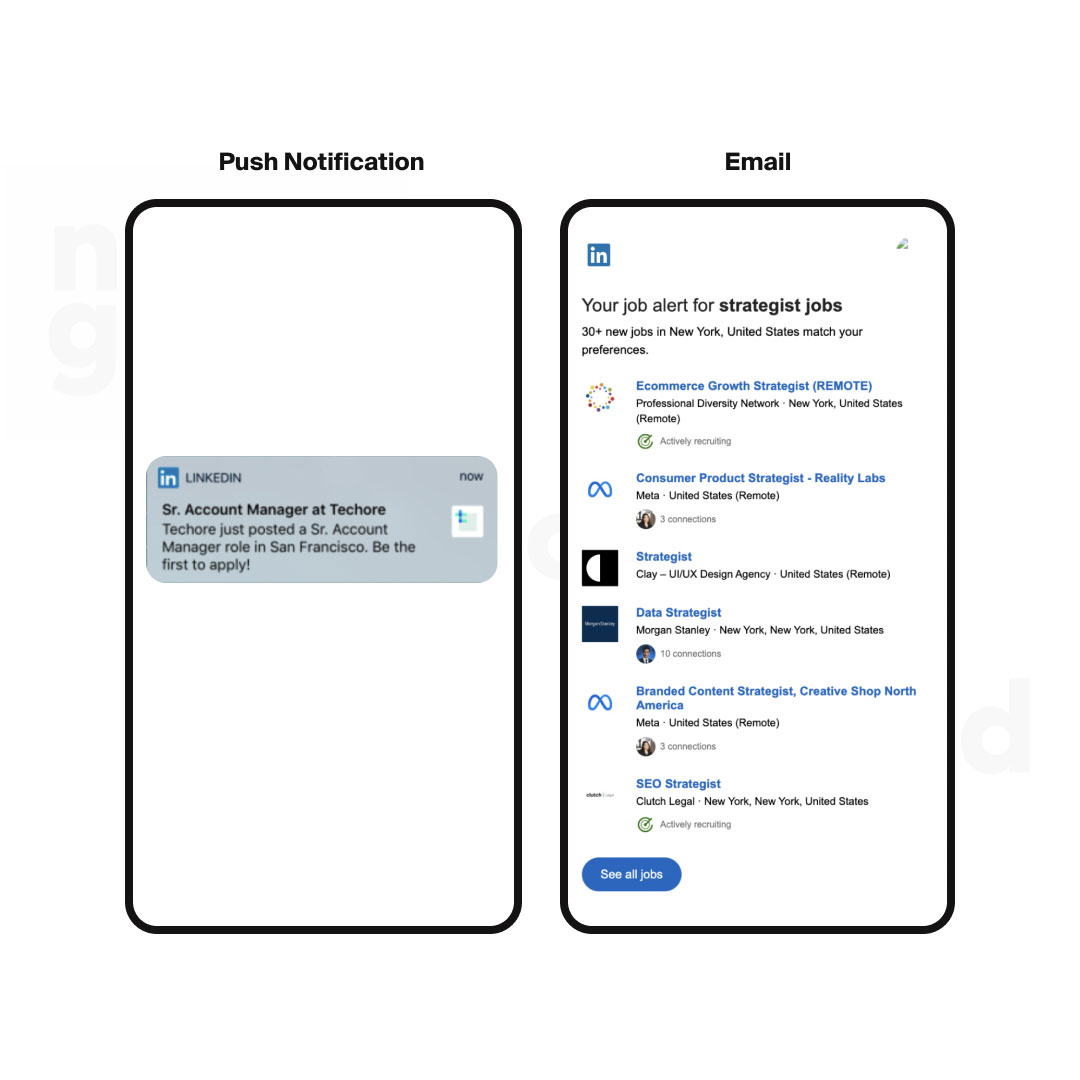
3. Personalize your push notifications to specific audience segments
Personalization of push notifications can increase open rates by 4x — but that depends on how it is executed and how granular the personalization is. It’s no longer enough for brands and marketers to merely use basic personalization techniques like including the user’s first name; simple personalization has less than a 1% impact on engagement rates, while greater personalization delivers much higher results. 61% of app users would open push notification messages that are related to their preferences, demonstrating the importance of using audience segments to better and more detailed personalizations.
Streaming platform apps are a common example of how personalization can be done based on specific audience segments. Many streaming platforms like Netflix, Hulu, HBO and Amazon Prime segment their audience through historical user behavior and their interest in specific genres or titles. With these segments, the platform is then able to send personalized push notifications for relevant new content recommendations. Someone who enjoys watching horror movies might receive push notifications about new movies in that genre, whereas someone who watched the previous season of a TV show might get a notification when a new season is released. By personalizing push notifications based on the audience segment that a user is in, you’re able to make sure that users are only receiving messages that are actually relevant to them and are more likely to lead to a conversion.

4. Be strategic and intentional with the timing of every send
Push notifications are by nature quick and short-lived, meaning that the the timing of the send should be data-backed, logical-backed, and strategically intentional for maximum impact. Most push notification marketing and customer engagement platforms have time zone send and smart send time capabilities that can automatically help you schedule sends at the right time for the right user. If your brand spans multiple regions, time zone sends ensure that the message is sent based on the user’s time zone; for example, if your app sends out a regular morning update at 9am every day, the time zone send can make sure that the message is scheduled for 9am at each user’s respective time zone. In a similar vein, smart send time sends messages based on the user’s previous activity, and schedules messages based on when the user is most likely to click on a message. Since the smart send time function is based on historical behavior, its accuracy and effectiveness is likely to increase as you send out more messages over time.
Another important factor to consider is time lags, also known as the amount of time between a certain user action and an automatically triggered push notification. Most push notifications serve the primary purpose of bringing a user back into the app, so it wouldn’t make sense to send a push notification to a user that is still active on the app. If a push notification is being triggered by a specific in-app action, such as purchasing a product, reading a piece of content or posting a certain image, it’s a good idea to add a time lag of at least 30 minutes to ensure that the user is not still actively using the app when they receive the push notification.
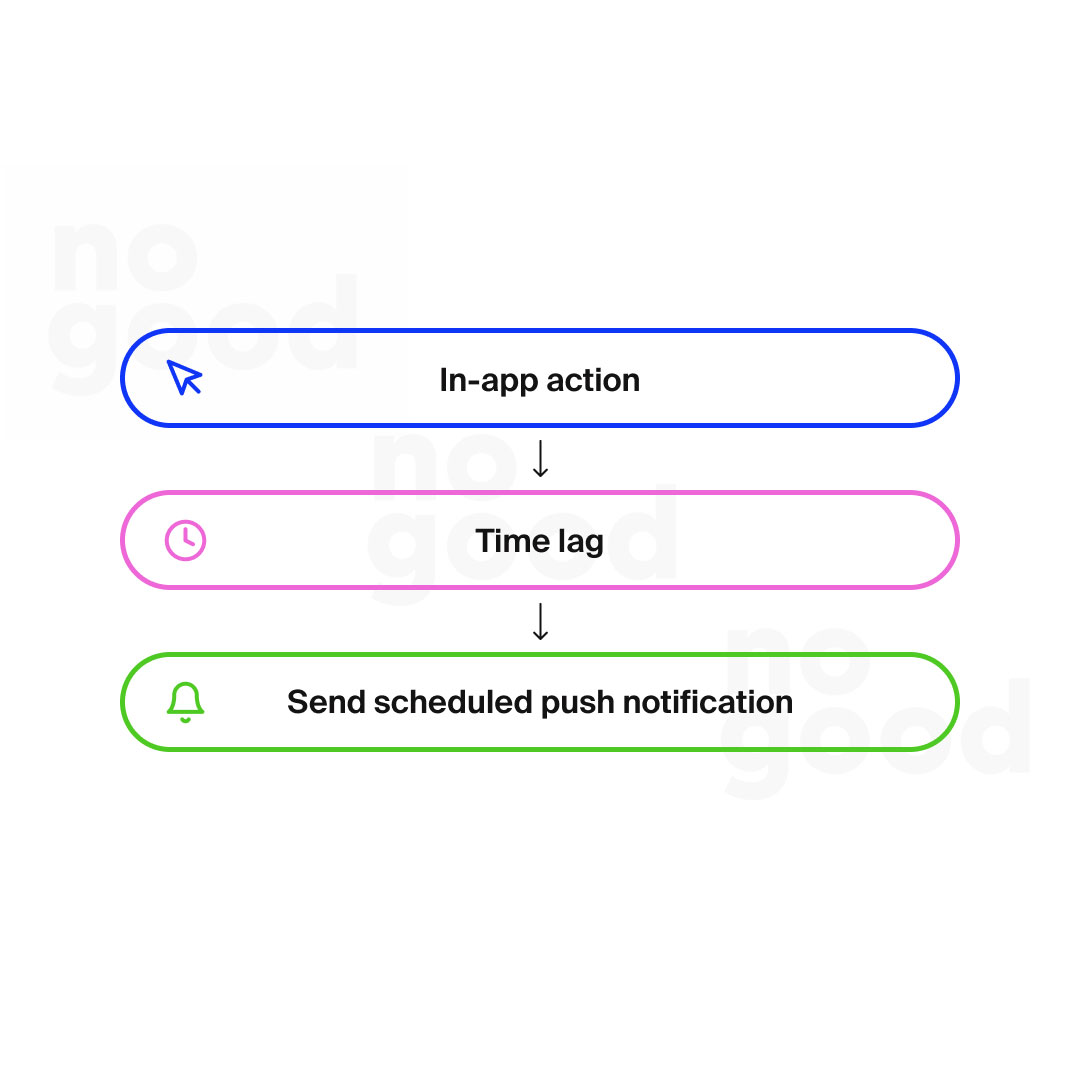
5. Use copywriting to arouse user interest and drive action
Push notifications are typically only approximately 100 characters long, meaning that there isn’t a lot of space for detail and elaboration. Effective push notification copywriting is short, attention-catching, and action-oriented, capturing the essence of the messaging goal in less than 2 sentences. Here are a few do’s and don’ts when it comes to writing effective push notifications:
- Do: keep it short and sweet
Get straight to the point with the limited space that you have
- Don’t: tell the full story
Leave some mystery or ask a question to pique user interest, so that they have to click into the notification to get their answer
- Do: include a clear CTA (call to action)
Frame your copy to be action-oriented to users know exactly what they should do upon clicking on the notification
- Don’t: write the message in third-person
Push notifications are a highly personal medium. Use first-person language to speak directly to the end user and make it feel like a one-on-one conversation.
- Do: use power words that are linked to higher click rates
Hook-like words like “exclusive”, “new”, “limited”, “save”, and “now” create a sense of urgency and excitement that will drive the user to action
Start Using Push Notifications To Power Up Your Retention Rates
Meet your users exactly where they are and foster a direct relationship with your key audience segments through push notification marketing. By using segmentation and personalization techniques that are backed in user insights and behavioral data, you can deliver relevant content to your users at the point where they are most likely to engage with your product.
If you need additional support on getting your push notification marketing strategy set up and running, we’re always here to help.





